令和元年09月14日 土曜日号
“情熱 平成30年”
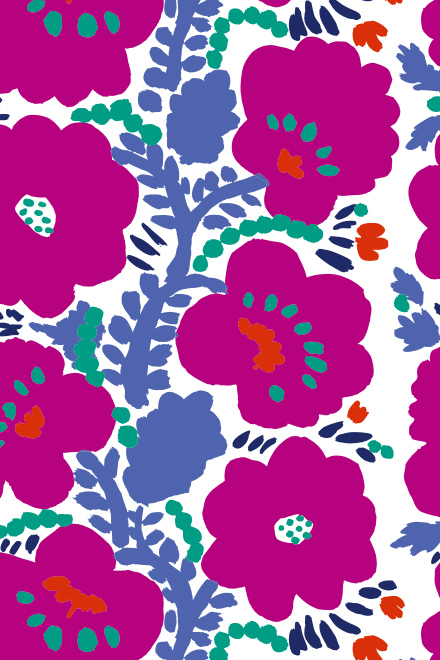
画面いっぱいに
のびのびと花を描く
茎でつないでいって
葉と実も描き加える
描いた時の気持ちそのままに
情熱的な1枚になった
(脇阪克二)
Passion (2017,by Katsuji Wakisaka)
Firstly I drew some energetic flowers to fill the whole paper.
And then the flowers are joined together by the stalks I gave them.
Finally, they come into leaves and bear fruits.
These passionate flowers reflected my mind while I was drawing.
| English translation by LI XIAO XIAO |
Passion (2017, par Katsuji Wakisaka)
Je dessine plein de fleurs
sur un écran, dont les tiges
rejoignent les feuilles et les fruits.
Mon état d’esprit est retranscris
tel quel dans ce dessin: la passion.
| Traduction française par Jean-Baptiste Fauvel |
熱情 (2017, 脇阪 克二)
先畫出不停往上生長的花,
將紙填滿。
再用莖將花連結,
加上葉子和果實。
我將創作時的心情直接映照於紙上
於是誕生了這幅充滿熱情的畫。
| 中譯 : 李 瀟瀟 |
→こちらのテキスタイルデザイン商品
(Textile products with this pattern)
令和元年09月11日 水曜日号
“十数おもちゃ箱 平成25年”
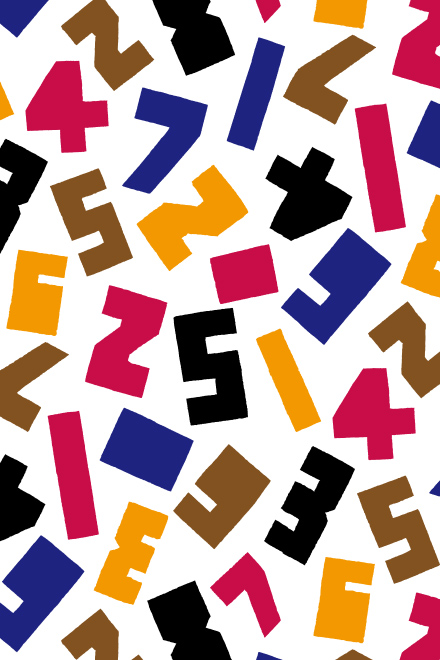
子供達のおもちゃ箱の中には
いろんなものが入っている。
色も形もいろいろあってにぎやかだ。
ひとつひとつ見ていると
彼らが小さかった日の状景が浮かんでくる。
忘れていた出来事も思い出されてくる。
過ぎ去った年月は戻らないが
思い出はいつまでも生き続ける
(脇阪克二)
Toy box (2013, by Katsuji Wakisaka)
Kid's treasure box is filled with toys,
of various colors and shapes.
Take them one by one in hand
and it may recall those memories of childhood
that people may have fogotten.
Days are gone never to return,
but the memories never fade away.
| English translation by LI XIAO XIAO |
Boites à jouer (2013, par Katsuji Wakisaka)
Il y a de nombreux objets
dans les boites à jouer des enfants.
De toutes les couleurs et de toutes les formes.
Quand on les regarde un à un,
on se souvient des moments passés ensemble,
de ces lointains souvenirs longtemps oubliés.
Les jours passés ne reviennent pas mais
les souvenirs continuent d’exister.
| Traduction française par Jean-Baptiste Fauvel |
十數玩具盒 (2013, 脇阪 克二)
小朋友的玩具盒裝著很多寶貝,
不同顔色,不同形狀,熱鬧地躺在裡面。
長大一點後再打開盒子,一件件翻看,
總會想起很多兒時的場景。
時光不停往前,記憶褪色淡去,
但回憶卻永遠鮮活可愛。
| 中譯 : 李 瀟瀟 |
令和元年08月27日 火曜日号
“秋の夜 令和元年”

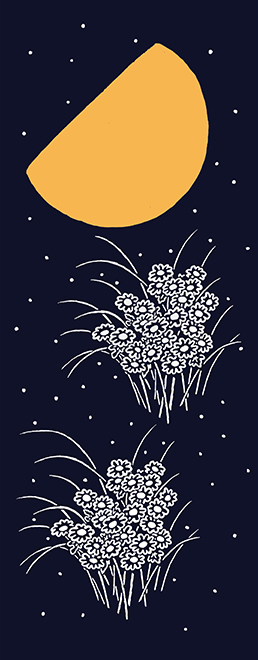
秋の夜の楽しみは
澄みわたった夜空に浮かぶ
月だろう
暑かった夏も 勢いを弱め
朝夕は気持よい季節になって
虫の音が聞こえるようになる
菊の花も咲きはじめ
これから秋本番となる
(脇阪 克二)
Autumn Night(2019, by Katsuji Wakisaka)
Autumn moon hanging on the autumn clear night sky.
It might be the climax of the autumn days.
As the summer heat goes down,
Days and nights have cooled down.
Autumn comes,
as the chirping of insects starts to be heard,
and the chrysanthemum bursts.
| English translation by LI XIAOXIAO |
Nuit d’automne (2019, par Katsuji Wakisaka)
La joie des nuits d’automne réside surement
dans la lune qui flotte dans le ciel clair d’automne.
Au fur et à mesure que la chaleur estivale diminue,
les jours et nuits deviennent de plus en plus agréables.
L’automne arrive enfin à nous,
aux chants des insectes de plus en plus audibles
et aux couleurs des chrysanthèmes qui fleurissent.
| Traduction française par Jean-Baptiste Fauvel Matsumoto |
秋夜(2019, 脇阪 克二)
秋夜之趣
莫過於欣賞澄澈夜空中的那輪明月
夏天的暑熱漸漸消退
清晨和傍晚變得舒適涼爽
耳邊傳來秋天的蟲鳴
菊花開始燦爛綻放
秋天已經拉開帷幕
| 中譯 : 李 瀟瀟 |
→こちらのテキスタイルデザイン商品
(Textile products with this pattern)
令和元年08月03日 土曜日号
“切り絵 平成29年”
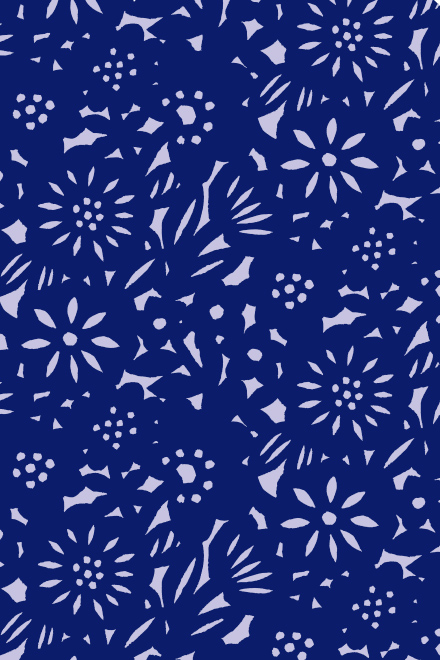
カッターを使って紙を
切り抜いていく
筆で描く様に
自由に表現できない
その不便さが切り絵の良さであり
独特のふんいきを生み出してくれる
(脇阪克二)
Cutouts (2017, by Katsuji Wakisaka)
Cut out picture can't provides smooth lines as brush drawing.
On the contrary, you will never find a simplicity and details
with such unique clear look in any other paintings but the paper cutout pictures.
| English translation by LI XIAO XIAO |
Assemblage de papiers (2017, par Katsuji Wakisaka)
Je découpe du papier avec un cutter.
A l’inverse d’un dessin au pinceau,
Ma liberté d’expression est limitée.
Cette difficulté fait partie de la beauté de cette pratique,
créant un monde et un rendu uniques.
| Traduction française par Jean-Baptiste Fauvel |
剪紙 (2017, 脇阪 克二)
剪紙畫,
不同於用筆作畫,
無法自由流暢地創作出想要描繪的畫面。
但那不由衷的笨拙生硬,
也正是剪紙畫的獨特魅力之所在
| 中譯 : 李 瀟瀟 |
→こちらのテキスタイルデザイン商品
(Textile products with this pattern)
令和元年07月25日 木曜日号
“ひさご 令和元年”

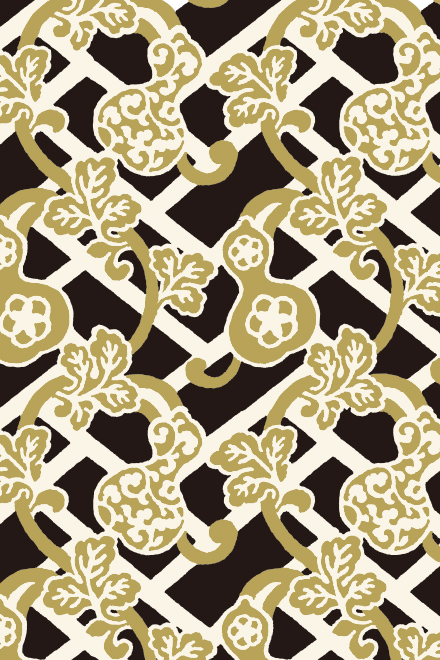
ひさごとは瓢箪のことで
うり科の植物の中身をくりぬき
乾燥させて作られる
酒や水 七味唐辛子の容器
として使用されてきた
縁起物として 掛け軸や器
染物の意匠として愛されてきた
これも能衣裳の模様
武将が旗印や馬印としても
用いられてきた
(脇阪 克二)
Hisago(2019, by Katsuji Wakisaka)
Hisago or gourd, is commonly hollowed and dried to use as
a sake or water container, as well as a seasoning holder.
As it's supposed to bring luck in Japan,
You can also find gourd pattern on hanging scrolls, tableware,
and traditional textile design as a decorative motif.
My hisago design is origined from gourd pattern printed on
costume for Noh stage, and banner or flag of famous samurai warriors.
| English translation by LI XIAOXIAO |
Hisago(2019, par Katsuji Wakisaka)
Hisago fait référence à la calebasse,
de la famille des cucurbitacées,
dont la chair est extraite et séchée.
Elle est également utilisée comme récipient
pour le saké, l’eau ou bien le Shichimi.
Particulièrement appréciée pour la conception
d’amulettes, de rouleaux suspendus, de récipients
ou encore pour le tissage, elle fut aussi utilisé
comme bannière par des shoguns.
| Traduction française par Jean-Baptiste Fauvel Matsumoto |
葫蘆(2019, 胁阪 克二)
瓜類植物葫蘆,挖空曬乾,
常用作裝酒水、辣椒粉等調味料的容器。
葫蘆寓意「福祿」,自古多用於各種畫卷、器物和服飾紋樣中。
作爲染印織品紋樣的葫蘆,
常見於日本傳統「能劇」的舞臺服裝、武將的旗幟花紋和馬印(將領大旗)的圖形中。
| 中译 : 李 瀟瀟 |
→こちらのテキスタイルデザイン商品
(Textile products with this pattern)
令和元年07月17日 水曜日号
“松ぼっくり 平成30年”
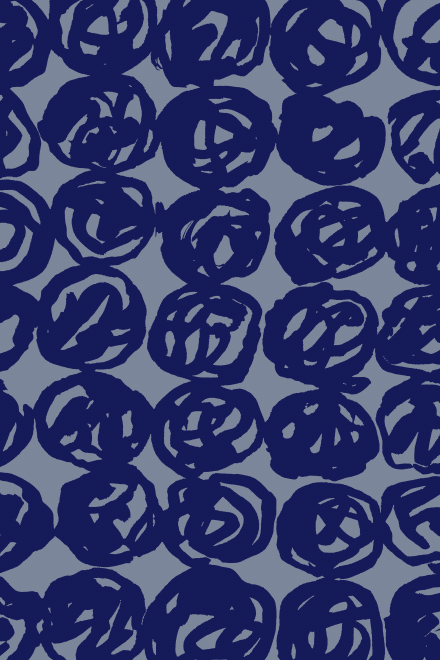
筆でぐるぐる ぐるぐると
あまり考えず 描く
無心になって 描くのは
むつかしいものだが
これは 人をドキドキさせるような
面白さが出た
(脇阪克二)
Pine cone (2018, by Katsuji Wakisaka)
Without deep thinking,
I sketched some rings to express pine cones.
It's not easy to draw something spontaneously,
but I hope these pine cones provide some unparalleled fun.
| English translation by LI XIAO XIAO |
Pomme de pin (2018, par Katsuji Wakisaka)
Je dessine sans réfléchir ,
au gré des fantaisies de mon pinceau.
Il est difficile de dessiner sans rien penser
mais c’est dans ces moments que se créer
des motifs touchants et émouvants.
| Traduction française par Jean-Baptiste Fauvel |
松果 (2018, 脇阪 克二)
我隨意在紙上一圈一圈地描出這些松果。
無心作畫,并非易事,
但同時也創造出某種新鮮而
不可思議的可愛模樣。
| 中譯 : 李 瀟瀟 |
→こちらのテキスタイルデザイン商品
(Textile products with this pattern)
令和元年07月13日 土曜日号
“ぐんぐん 平成29年”
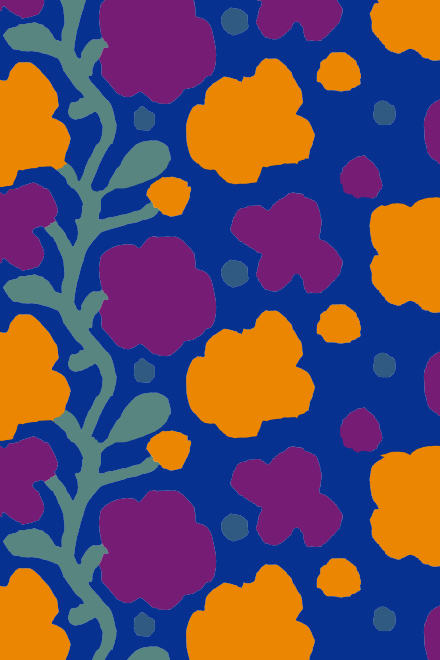
植物は茎を上へ上へと
伸ばして 成長していく
土と太陽と水があれば
ぐんぐん力をつけていく
そして 大輪の花を咲かせる
(脇阪克二)
Vitality (2017, by Katsuji Wakisaka)
Plants grow steadily,
extending their stems upward.
Plants grow steadily,
as long as there is soil, sunlight and water.
Plants growing up strong and healthy,
and then create a splendid blossom.
| English translation by LI XIAO XIAO |
Petit à Petit (2017, par Katsuji Wakisaka)
Les tiges des plantes grandissent
petit à petit, toujours plus haut.
Grâce à la terre, le soleil et l’eau,
elles se fortifient petit à petit.
Puis, elles laissent place à de grandes fleurs.
| Traduction française par Jean-Baptiste Fauvel |
茁壯 (2017, 脇阪 克二)
植物的莖奮力向上生長,
只要有泥土,太陽,雨水,
便一刻不停,氣勢蓬勃,日茂葱鬱。
然後開出大朵大朵的花來。
| 中譯 : 李 瀟瀟 |
→こちらのテキスタイルデザイン商品
(Textile products with this pattern)
令和元年07月06日 土曜日号
“紗綾形 平成26年”
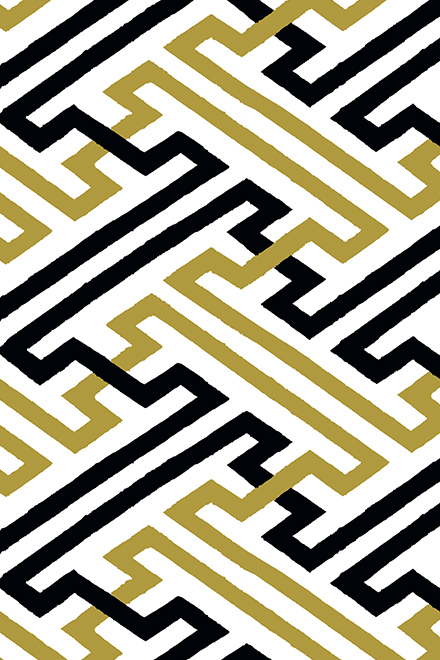
一見迷路のようだが
昔からあるもので卍形を模様にしたもの。
着物の地紋や模様の背景に使われ親しまれてきた。
大岡越前のお裁きの場の襖絵として
見たことのある人も多いと思う。
とても単純な模様をくりかえしている
だけなのに大胆で美しい。
テキスタイルデザインのお手本のような模様だ。
(脇阪克二)
Sayagata (2014, by Katsuji Wakisaka)
It looks like a maze at a glance,
but is a traditional pattern that uses connected 卍 patterns.
Sayagata was familiar as woven pattern of Kimono,
or background of other patterns.
It is also well known as a painting on a fusuma
of the judgement room of Echizen Ōoka,
a Japanese samurai in the service of the Tokugawa shogunate.
Although it is a repetition of very simple patterns,
it is daring and beautiful.
I think Sayagata is like a model of textile design.
| English translation by Futaba Komori |
Motif Saya (2014, par Katsuji Wakisaka)
A première vu, cela ressemble à un labyrinthe mais
il s’agit d’un motif très ancien dérivé de la svastika.
Il est très connu, souvent utilisé pour les motifs de kimonos.
Beaucoup de personnes l’ont déjà vu sur les motifs
de fusuma lors des jugements du célèbre Echizen Ōoka.
Le simple fait de répéter plusieurs fois ce motif si simple
lui confère un caractère particulier et une beauté unique.
On peut le considérer comme un motif de base pour les textiles.
| Traduction française par Jean-Baptiste Fauvel |
紗綾形 (2014, 脇阪 克二)
紗綾形乍看之下像迷宮,
是常用在和服底紋中的圖案。
時代劇大岡越前中著名場景的隔扇畫,
也是紗綾形。
只是單純重複的紋樣,
卻有一種大膽的美。
可以說,紗綾形是織物設計的範本紋樣。
| 中譯 : 李 瀟瀟 |
→こちらのテキスタイルデザイン商品
(Textile products with this pattern)
令和元年06月25日 火曜日号
“涼やか 令和元年”

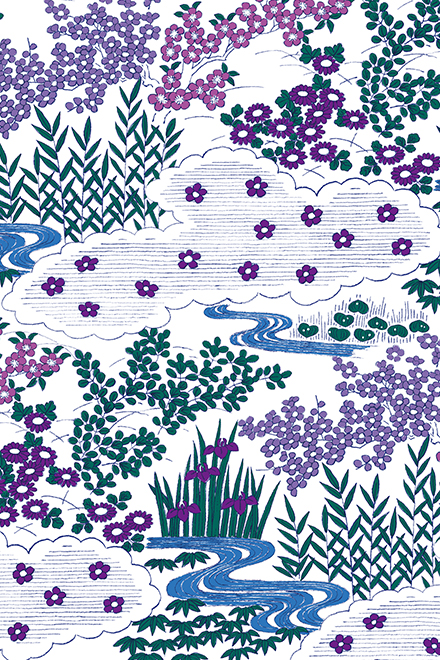
むし暑い日本の夏
見た目にも 涼しくありたいと
着物の意匠は
いろいろ工夫されてきた
雲がわき、水が流れ
四季のさわやかな花が心地いい
昔の麻の着物から
インスピレーションを受けたデザイン
(脇阪 克二)
Refreshing pattern(2019, by Katsuji Wakisaka)
Japanese put a lot of thought into the pattern design of kimono.
Rolling clouds, flowing water and various refreshing flowers for seasons are designed for the hot and humid summer in Japan.
I got my inspiration from those old linen kimono designs to create this pattern.
| English translation by LI XIAOXIAO |
Design tout frais(2019, par Katsuji Wakisaka)
Les Japonais mettent beaucoup d’importance dans le design des kimonos.
Des nuages flottants, de l’eau courante ou des fleurs de saisons sont
dessinés en fonction de l’été japonais si chaud et si humide.
Je me suis inspiré de ces anciens kimonos en lin pour créer mon design.
| Traduction française par Jean-Baptiste Fauvel Matsumoto |
清涼(2019, 胁阪 克二)
日本的夏天溽熱難耐。
人們在和服紋樣上下功夫,
流水潺潺,行雲片片,
四季的花,清新爽朗。
我從這些傳統的麻料和服紋樣中獲得靈感,
畫出這張「清涼」。
| 中译 : 李 瀟瀟 |
→こちらのテキスタイルデザイン商品
(Textile products with this pattern)
令和元年06月22日 土曜日号
“すずしろ 平成25年”
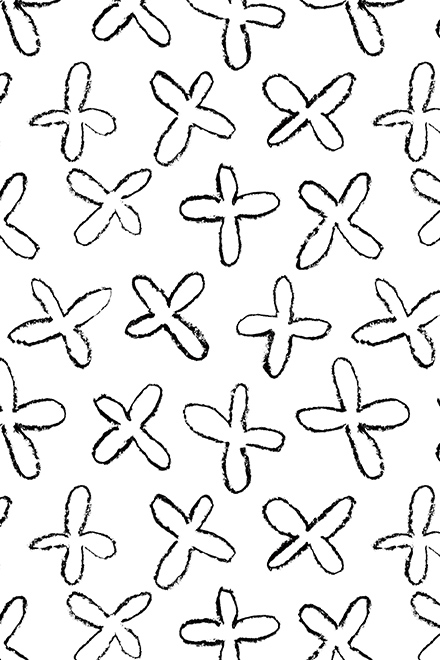
白くすこやかなすずしろ草の花。
ちょっとかすれた線で
花の素朴さと力強さを。
野山に咲く花は
飾り気がなくて美しい。
(脇阪克二)
Arabis flagellosa (2013, by Katsuji Wakisaka)
White, healthy flower of Arabis flagellosa.
By drawing with slightly blurred lines,
I express the artless elegance and strength of the flower.
Wildfloers are beautiful just the way they are.
| English translation by Futaba Komori |
Suzushiro (2013, par Katsuji Wakisaka)
La fleur de Suzushiro, si blanche et vigoureuse.
Ses lignes inégales lui confèrent simplicité et force.
Les fleurs de montagnes, sans prétention aucune, sont si belles.
| Traduction française par Jean-Baptiste Fauvel |
蘿蔔草 (2013, 脇阪 克二)
蘿蔔草開出白色的花,
我用飛白手法表現它們的樸質頑强。
野花有野花的美,
并不嬌嫩,卻多姿颯爽。
| 中譯 : 李 瀟瀟 |
→こちらのテキスタイルデザイン商品
(Textile products with this pattern)
令和元年06月05日 水曜日号
“ゆるやか 平成30年”

くずれそうになりながら くずれず
ゆるやかな ふんいきを持った花
きちっとしたものより
ゆるやかなものの方が
自由な表現が出来る
(脇阪克二)
Gentle (2018, by Katsuji Wakisaka)
Very delicate yet keeping its shape -
this flower has a gentle atmosphere.
In its gentleness,
I can find a space for my free expression.
| English translation by Futaba Komori |
Douceur (2018, par Katsuji Wakisaka)
Si fragile et pourtant si forte,
Une fleur douce et savoureuse.
Plutôt que pour des choses rigides,
il est plus facile de laisser libre court à son imagination
pour représenter des choses douces.
| Traduction française par Jean-Baptiste Fauvel |
緩和 (2018, 脇阪 克二)
你看這些花,柔和隨意
似要散落卻不凋零。
寫意描繪出的花,
比苛求工細畫出的多一層自由,
神態表現更加柔緩。
| 中譯 : 李 瀟瀟 |
→こちらのテキスタイルデザイン商品
(Textile products with this pattern)
令和元年05月29日 水曜日号
“えんぴつ 平成24年”
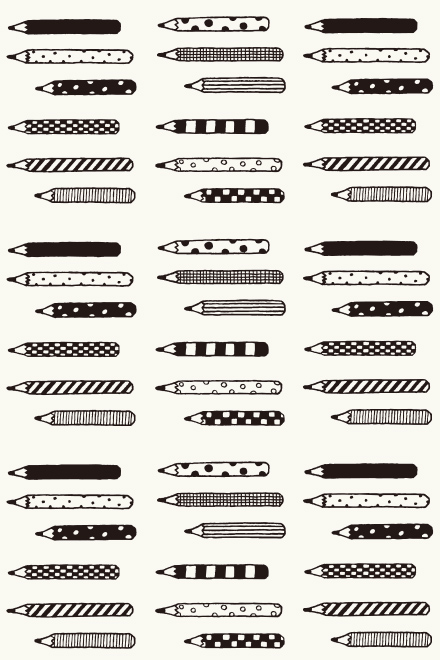
僕は鉛筆が好きなので
毎日使っている。
目的によって2Hから10Bまで
使い分ける。
文章を書くときは、濃くて太目の
6Bくらいのものを使う。
鉛筆は木で出来ているので
それをけずるのも楽しい。
仕事を始める前にカッターナイフで
鉛筆をけずっていると
気持が落ち着き集中してくる。
(脇阪克二)
Pencil (2012, by Katsuji Wakisaka)
I love pencils,
I use them every day,
ranging from 2H to 10B for various purposes.
I usually pick 6B for writting texts.
Pencils are often made of wood, which make it enjoyable to sharpen.
Before starting my work,
Sharpening a pencil allows me
to calm down and concentrate.
| English translation by LI XIAO XIAO |
Crayon (2012, par Katsuji Wakisaka)
J’adore les crayons, c’est pourquoi
j’en utilise tous les jours.
Selon mes objectifs, j’utilise des crayons
allant du 2H au 10B.
Quand j’écris des textes, j’aime écrire
avec des traits bien marqués avec du 6B.
Les crayons sont bien souvent en bois,
ce qui les rend amusant à tailler.
Avant de commencer à travailler,
tailler mes crayons au cutter me permet
de me calmer et de me concentrer.
| Traduction française par Jean-Baptiste Fauvel |
鉛筆 (2012, 脇阪 克二)
我畫畫很喜歡用鉛筆,
幾乎每天都在用。
從2H到10B,
根據不同用途選擇粗細。
寫文章的時候通常用較粗的6B。
鉛筆都是用木頭做成的,
削鉛筆這件事也讓我頗爲着迷。
下筆之前一刀一刀削筆的過程,
能平復我内心,如止水而下筆。
| 中譯 : 李 瀟瀟 |
→こちらのテキスタイルデザイン商品
(Textile products with this pattern)
令和元年05月25日 土曜日号
“番傘に水玉 平成31年”


昔は 日常 使われる多くの物が
竹で作られていて
生活に彩りを与えていた
太い竹の骨に厚い油紙を
貼った ふだん使いの番傘は
竹の勢い 力強さが
魅力だった
狂言の衣裳に番傘の模様
があり それに水玉を
加えたもの
(脇阪 克二)
Ban-gasa umbrella and Dots(2019, by Katsuji Wakisaka)
Ban-gasa, or traditional Japanses collapsible umbrella is widely used in the old time.
It consit of strong bamboo and thick oil paper,
expressing the tensile strength of bamboo.
Ban-gasa pattern is printed on the stage costume for Kyogen, a Noh farce.
I arranged some poppy polka dots in it.
| English translation by LI XIAOXIAO |
Goutte d'eau sur parapluie (2019, par Katsuji Wakisaka)
La plupart des objets d’autrefois
était construit en bambou,
ajoutant de la couleur à nos vies quotidiennes.
Les parapluies usuels en bambou énorme
recouverts de papiers huilés épais étaient fascinants
de par la force et la puissance naturelle du bois.
Il existe des motifs de ces « bangasa » dans le Nōgen,
auxquels j’ai rajouté des gouttes d’eau pour créer ce design.
| Traduction française par Jean-Baptiste Fauvel Matsumoto |
番傘與圓點(2019, 胁阪 克二)
番傘,是古代日本人普遍使用的一種和傘,
用厚實的竹子做傘骨,貼上油紙做傘面,
自然點綴著人們的日常生活。
一把番傘,演繹著竹之勢,堅韌高雅。
我在日本古典戲劇“狂言”的服裝上看到番傘的印花0,
加之以圓點,繪成這張紋樣。
| 中译 : 李 瀟瀟 |
→こちらのテキスタイルデザイン商品
(Textile products with this pattern)
令和元年05月11日 土曜日号
“銀河系 平成20年”
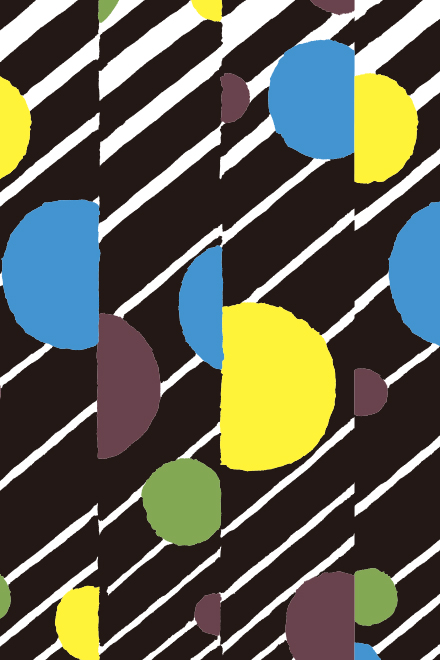
太陽のまわりをまわっている惑星は
大きさ、色、たたずまいがそれぞれ違い
独自の軌道を飛んでいる。
大宇宙の中で孤独に静かに
太陽のまわりをまわっている。
想像すると果てしない無限の世界へいざなわれる
(脇阪克二)
Galaxy (2008, by Katsuji Wakisaka)
Planets orbiting the sun,
Differs from each other in size, color and appearance.
Moving in their own orbits,
Lonely and quietly, never stop.
They revolving in my mind
I imagine how they revolving around the sun,
and it invites me into an infinite universe.
| English translation by LI XIAO XIAO |
Galaxie (2008, par Katsuji Wakisaka)
Les planètes qui tournent autour du soleil
ont toutes des tailles, couleurs et atmosphères différentes,
tout comme leurs propres orbites.
Elles tournent silencieusement et solitaire
autour du soleil dans le cosmos.
Notre imagination nous invite dans un monde infini.
| Traduction française par Jean-Baptiste Fauvel |
銀河系 (2008, 脇阪 克二)
太陽系的行星們
大小,顔色,外觀各不相同,
沿著各自軌道運行,
浩瀚宇宙中孤獨而沉寂。
想象那些星星,
圍著太陽轉啊轉,永不停歇,
思緒也陷入無邊的宇宙。
| 中譯 : 李 瀟瀟 |
→こちらのテキスタイルデザイン商品
(Textile products with this pattern)
令和元年05月04日 土曜日号
“花畑 平成23年”
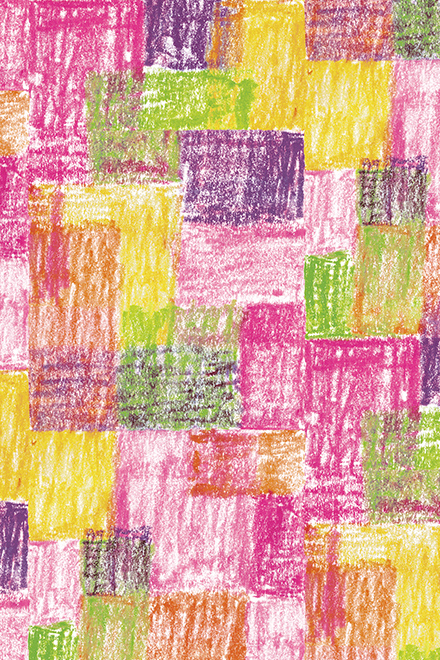
一面の花畑。
赤、オレンジ、黄、ピンク、紫の花が
時には一色で
時にはまざりあって咲いている。
クレパスで大胆に花畑を描いていく。
どこまでいっても花畑の感じを
細かいところを気にせず
どんどんぬりつぶしていく。
色の世界の花畑。
(脇阪克二)
Flower fields (2011,by Katsuji Wakisaka)
Red, orange, yellow, pink, purple...
Flower fields of various hues.
Sometimes key to solid color,
sometimes bloom in different colors.
I drew with crayons in an abstract sense.
Just filling the paper with color blocks,
to create my flower fields in the world of color.
| English translation by LI XIAO XIAO |
Champ de fleurs (2011, par Katsuji Wakisaka)
Un champ de fleurs à perte de vue.
Des fleurs rouges, oranges, jaunes, roses ou bien violettes
qui parfois s’unissent sous une même couleur
et parfois éclosent pour se mélanger entre elles.
Je m’apprête à dessiner aux pastels un champ de fleurs.
Je dessine sans vergogne et sans me soucier des détails
un champ de fleurs sans limites ni frontières.
Un champ de fleurs dans monde de couleurs.
| Traduction française par Jean-Baptiste Fauvel |
花田 (2011, 脇阪 克二)
一面花田。
紅色,橙色,黃色,粉色,紫色的花,
時而整齊一色,
時而繽紛爛漫。
我用蠟筆描繪花田,
不拘泥於百花之小巧精緻,
大膽用方形色塊表現,
塗出色彩世界之花田。
| 中譯 : 李 瀟瀟 |
→こちらのテキスタイルデザイン商品
(Textile products with this pattern)
令和元年05月01日 水曜日号
“牡丹唐草 平成30年”

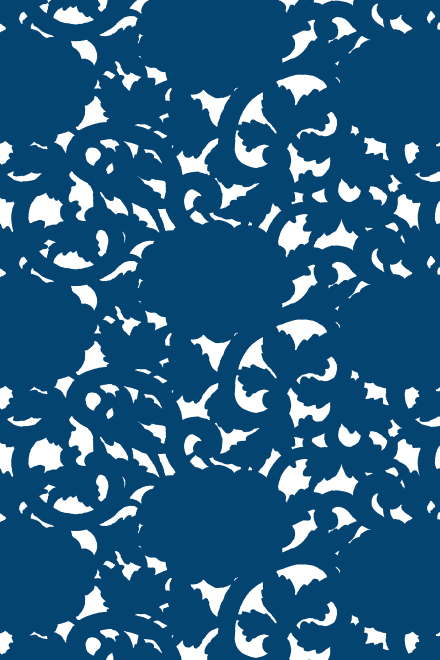
昔から人々に愛され、親しまれてきた
唐草模様は つる草を図案化したもの
人々は そこに からみ合う
人間社会の喜怒哀楽を
感じてきたのだろう
これは牡丹の花と葉を
つる草と組み合わせたもので
藍染の着物柄を参考にして作った。
(脇阪 克二)
"Arabesque with peony"(2018, by Katsuji Wakisaka)
Arabesque motif, or foliage scroll pattern
has been familiar to people through the ages.
It was like people are intertwined with each other,
I could even see their ups and downs in it.
I combined arabesque with peony refer to an indigo dyed kimono design.
| English translation by LI XIAOXIAO |
"Rinceaux de Pivoine"(2018, par Katsuji Wakisaka)
Aimé depuis la nuit des temps par les japonais,
le motif arabesque tire ses origines de la vigne.
Je me demande si les gens de l’époque ont lié
leurs propres émotions à ce type de motif.
Notre motif est un mélange entre la fleur de pivoine
et les fleurs de vignes, créé en prenant pour modèle des kimonos.
| Traduction française par Jean-Baptiste Fauvel Matsumoto |
"牡丹唐草"(2018, 胁阪 克二)
唐草紋樣是自古為日本人所熟知的藤曼圖紋,
世人葛蔓糾結其中。
凝視唐草,仿佛可以感知到人類社會的喜怒哀樂。
我的這件織物設計參考了藍染和服印花中
唐草與牡丹花葉結合的紋樣。
| 中译 : 李 瀟瀟 |
→こちらのテキスタイルデザイン商品
(Textile products with this pattern)
平成31年04月27日 土曜日号
“白つめ草 平成7年”
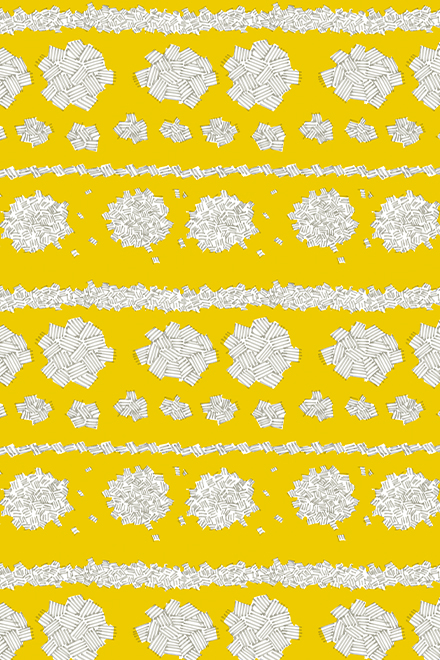
クローバーの日本名で
花は長い茎の先に
白いぼんぼりのような花をつける
それを編んで 首飾りや
髪飾りを作って
女の子達は楽しんでいる
今はあまり 見かけないが…
(脇阪克二)
White clover (1995,by Katsuji Wakisaka)
Japanese call trifolium repens as white clover.
They produces white flowers at the end of a tall stalk.
Girls enjoying braiding them into clover crowns and accessories.
However, it's not a usual sight these days.
| English translation by LI XIAO XIAO |
Trèfle blanc (1995, par Katsuji Wakisaka)
Nom japonais du célèbre trèfle,
sa fleur posée au bout d’une longue tige,
a des airs de lanternes en papier traditionnelles.
Les jeunes filles japonaises s’amusent à les tresser
pour en faire des colliers ou des couronnes.
Ce tableau est très rare de nos jours…
| Traduction française par Jean-Baptiste Fauvel |
白詰草 (1995, 脇阪 克二)
白詰草是三葉草的日本名,
長長的花莖頂端,
綻放白色球狀的花。
小女孩們將它摘下,
編成可愛的項鏈和髮飾,
與春天比美。
現在似乎很難見到這般可愛的光景了…
| 中譯 : 李 瀟瀟 |
→こちらのテキスタイルデザイン商品
(Textile products with this pattern)
平成31年04月24日 水曜日号
“ならんだ ならんだ 平成25年”
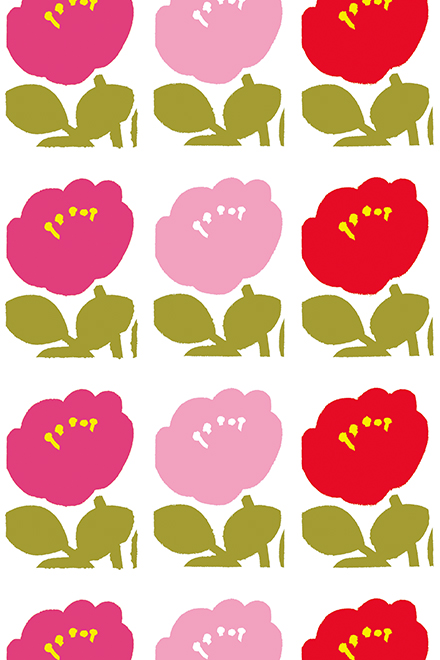
花模様を作るとき、
僕はあまり花を縦にも横にも
並べることはしない。
その方が流れがうまれ
テキスタイルデザインとしては
自然で使いやすいと思うから。
今回はあえて縦にも横にも並べてみた。
色も縦に並べることで、
逆に新しいリズムがうまれてきたようだ。
ならんだ、ならんだ、
バラの花がならんだ。
(脇阪克二)
Roses in line (2013,by Katsuji Wakisaka)
When I create a floral pattern,
I rarely arrange them in line or side by side.
Ruleless arrangement produces lively pattern,
stylish textile design for its ease of use.
I intentionally drew some flowers side by side,
as well as the color arrangement in line.
I'm surprised that it provide a new rhythm!
One after the other, roses in line...
| English translation by LI XIAO XIAO |
Les unes à la suite des autres (2013, par Katsuji Wakisaka)
Quand je crée un motif floral,
je ne répète que très rarement le même motif,
verticalement ou horizontalement.
Je pense qu’en procédant de la sorte, le design
textile nouvellement créé est plus naturel et intuitif.
Toutefois, je m’y suis prêté au jeu cette fois-ci.
En changeant par intermittence les couleurs,
un nouveau rythme semble s’être créé.
Les unes après les autres,
succession de roses…
| Traduction française par Jean-Baptiste Fauvel |
排一排,一排排 (2013, 脇阪 克二)
我創作以花為主題的織紋時,
很少采用橫向或縱向排列的方式。
不規則的排列,往往能產生自然流動態,
很適合用作紡織品紋樣。
在這幅印花中我不按常理地整齊排列,
連顔色也做了規整的縱向排列。
竟然意外奏響了新鮮的韻律。
排一排,
玫瑰花,一排排。
| 中譯 : 李 瀟瀟 |
平成31年04月20日 土曜日号
“かごめ編み 平成3年”
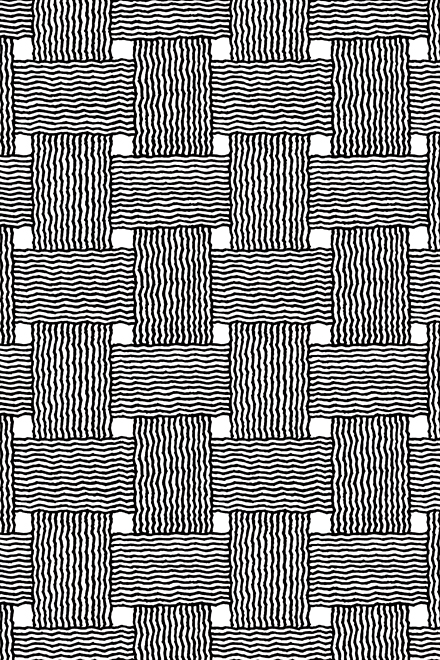
竹を編んだものを昔はいろいろなものに使っていた。
籠にして物を収納したり
バッグとして持ち歩いたりしていた。
天井、壁面などにも使われていた。
しっかり編みこまれていて丈夫。
自然素材なので、使っているうちに色も深みを加え
つやが出てきて美しくなってくる。
竹は日本の気候、風土に合っていて
日本人の感性にも訴えかけてくるものがある。
(脇阪克二)
Weaved bamboo (1991, by Katsuji Wakisaka)
In old days people weaved bamboo into many things -
weaved a basket to store things,
weaved a bag to carry around.
Bamboo were also used for ceiling and surface of wall,
they were firmly weaved and were solid enough.
As a natural material, the color will be deeper
and lustre comes out as time passes.
Bamboo suits the climate of Japan,
and also matches the sensibility of people living in this country.
| English translation by Futaba Komori |
Tressage Kagome (1991, par Katsuji Wakisaka)
Autrefois, le bambou était tressé pour créer des objets.
Parfois utilisé pour les récoltes sous forme de panier,
Parfois utilisé pour se promener sous forme de sac.
Il était même utilisé pour la confection des plafond ou des murs.
Une fois bien tressé, il est très résistant.
Étant une matière première naturelle, on peut l’embellir
en la polissant ou la peignant.
Il est adapté au temps et aux températures japonaises,
et il correspond à la sensibilité japonaise.
| Traduction française par Jean-Baptiste Fauvel |
竹編(1991, 脇阪 克二)
竹編的物件,自古就被廣汎使用於日常生活中。
編成竹籠用來收納,
編成竹包携帶裝物,
編成天花板,甚至墻壁,緊致結實。
天然素材的竹,經年顔色加深,
散發出歲月的光澤,那是年歲之美。
竹,契合日本風土氣候之素材,
激發日本人獨特的感悟。
| 中譯 : 李 瀟瀟 |
→こちらのテキスタイルデザイン商品
(Textile products with this pattern)
平成31年04月17日 水曜日号
“絵具皿 平成5年”
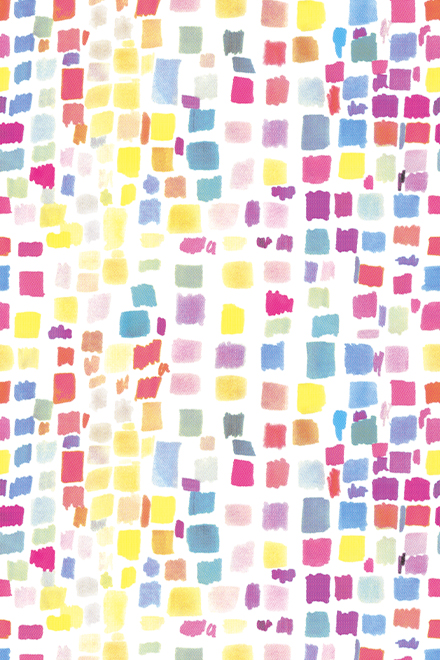
絵具皿にチューブから色を出してまぜ合せる。
いくつもの色をまぜ合せて
組合せのいい色をつくり出す。
きれいな色の組み合せが出来ると
それだけでイメージがわいてくる。
色は人の情感にうったえかけてくる。
素敵な色を見ると
人はそれだけで魅かれていく。
(脇阪克二)
Palette(1993, by Katsuji Wakisaka)
By squeezing paints from tubes, and mixing several colors together
I make a nice combination of colors.
When I could make beautiful color combinations,
those would bring a clear picture in my head.
They have power to rouse people's emotions.
Nice colors attracts people at first sight.
| English translation by Futaba Komori |
Palette de peinture (1995, par Katsuji Wakisaka)
Je mets des peintures sur une palette et je les mélange.
Je mélange une multitude de couleur et je créé des couleurs.
Créer ces nouvelles couleurs suffit à se faire une image globale.
Les couleurs font appel aux sentiments.
En regardant simplement de magnifiques couleurs,
l’homme peut être totalement fasciné.
| Traduction française par Jean-Baptiste Fauvel |
調色盤(1995, 脇阪 克二)
把各色顔料擠在調色盤上,
自由混合幾種,調出新色。
偶然調出好看的顔色,
眼前即浮現出想繪之畫面。
人哦,
只看一眼可愛的顔色,
就被之吸引,爲之着迷。
| 中譯 : 李 瀟瀟 |
→こちらのテキスタイルデザイン商品
(Textile products with this pattern)


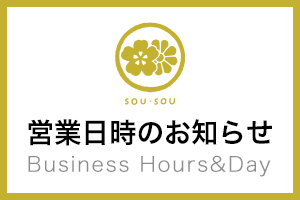


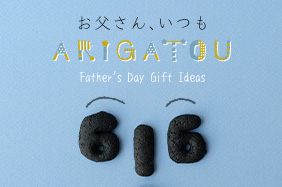
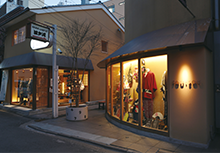
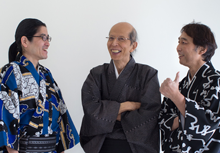

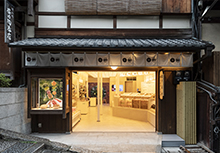

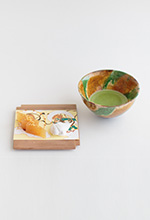
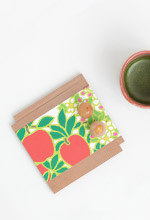










 お問い合わせ窓口
お問い合わせ窓口










